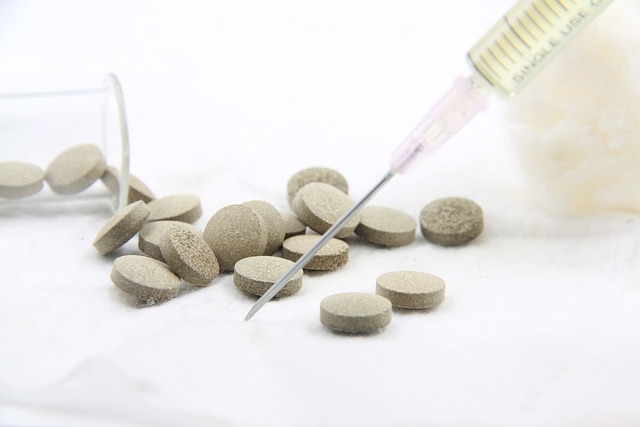Type 2 diabetes, characterized by insulin resistance and high blood sugar, is managed through lifestyle changes and medications like semaglutide, which mimics natural hormones. Early symptoms include thirst, frequent urination, fatigue, and weight loss. Semaglutide, a groundbreaking medication, regulates blood sugar levels by stimulating insulin production and suppressing glucagon release. Its dual action promotes weight loss and simplifies treatment. With weekly injections, it offers sustained blood sugar control, reduces hypoglycemia risk, and improves cardiovascular outcomes. Lifestyle modifications, such as diet and exercise, enhance its effectiveness. The future of diabetes care focuses on personalized medicine and advanced technologies, aiming to revolutionize patient outcomes.
Treating Type 2 Diabetes with Semaglutide: A Comprehensive Guide
Type 2 diabetes is a chronic condition affecting millions, characterized by elevated blood sugar levels. This article provides an in-depth look at innovative treatments, focusing on semaglutide medication as a game-changer in diabetes management. We’ll explore the causes and symptoms of type 2 diabetes, delving into how semaglutide works to regulate blood sugar. Learn about its benefits, injection techniques, potential side effects, and lifestyle adjustments to optimize its effectiveness. Discover the long-term impact and future prospects of this revolutionary treatment option.
Understanding Type 2 Diabetes: Causes and Symptoms

Type 2 diabetes is a chronic condition that affects how your body processes blood sugar (glucose). It occurs when cells become resistant to insulin, a hormone produced by the pancreas that allows glucose to enter and fuel your cells. As a result, glucose builds up in the bloodstream, leading to high blood sugar levels. Over time, the pancreas may also stop producing enough insulin to keep up with demand.
While there’s no cure for type 2 diabetes, it can be managed effectively. Lifestyle changes such as regular exercise and a balanced diet are crucial. Medications like semaglutide can also play a significant role in controlling blood sugar levels by mimicking the effects of natural hormones. Symptoms may include increased thirst, frequent urination, fatigue, weight loss, blurred vision, slow-healing wounds, and recurrent infections. Recognizing these early signs is essential for prompt treatment and management to prevent complications.
Semaglutide Medication: An Innovative Treatment Option

Semaglutide medication has emerged as a game-changer in the management of type 2 diabetes. This innovative treatment option mimics the effects of a natural hormone, GLP-1 (glucagon-like peptide-1), which helps regulate blood sugar levels by stimulating insulin production and suppressing glucagon release. Semaglutide is typically administered via weekly injections and has been shown to significantly reduce HbA1c levels, improve glycemic control, and promote weight loss in patients with type 2 diabetes.
Compared to traditional antidiabetic medications, semaglutide offers several advantages. It provides sustained blood sugar control throughout the day, reduces the risk of hypoglycemia (low blood sugar), and has a once-weekly administration schedule, making it more convenient for patients. Additionally, clinical trials have demonstrated its effectiveness in improving cardiovascular outcomes, further underscoring its potential as a long-term solution for managing type 2 diabetes.
How Semaglutide Works to Lower Blood Sugar Levels

Semaglutide is a medication that has made significant strides in managing type 2 diabetes. Its unique mechanism of action involves mimicking the effects of a natural hormone, GLP-1 (glucagon-like peptide-1), which plays a crucial role in regulating blood sugar levels. By acting as a substitute for this hormone, semaglutide stimulates insulin production and suppresses glucagon release, leading to a reduction in blood glucose. This dual action helps lower blood sugar levels by increasing insulin’s ability to remove glucose from the bloodstream while decreasing the liver’s production of glucagon, which can raise blood sugar.
The medication is particularly effective in improving glycemic control, making it a valuable tool for diabetes management. Its ability to delay gastric emptying also contributes to feelings of fullness and reduced appetite, which can aid in weight management—a common challenge for individuals with type 2 diabetes. Semaglutide’s mechanism not only simplifies the treatment process but also offers potential long-term benefits, including a lower risk of diabetes-related complications.
Benefits of Incorporating Semaglutide into Your Diabetes Management Plan

Incorporating semaglutide medication into your diabetes management plan can offer significant benefits, especially for those with type 2 diabetes. This injectable drug is a game-changer in the treatment landscape due to its dual action. Not only does it help lower blood sugar levels, but semaglutide also promotes weight loss, making it an effective tool for managing both aspects of this chronic condition. By mimicking a natural hormone that regulates appetite and insulin release, semaglutide assists in achieving better glycemic control while reducing hunger pangs.
The benefits extend further; semaglutide has been shown to decrease the risk of various diabetes-related complications. Its ability to lower blood pressure and improve cardiovascular health is well documented, providing much-needed protection for individuals with type 2 diabetes who are at a higher risk of heart disease and stroke. Additionally, its effect on lipid levels contributes to a healthier overall profile, further reducing the chances of developing diabetic complications such as nerve damage or kidney issues.
Administering Semaglutide: Injection Techniques and Frequency

Semaglutide, a medication known for its effectiveness in managing type 2 diabetes, is typically administered via injection. The injection technique involves inserting the needle into the subcutaneous tissue, just beneath the skin’s surface. This method allows for the slow release of semaglutide into the bloodstream over time. The frequency of injections can vary depending on the prescribed dosage and the patient’s response to treatment.
Doctors often recommend once-weekly injections for semaglutide medication, though this may be adjusted based on individual needs. Proper technique is crucial to ensure optimal absorption and minimize discomfort. Patients should rotate injection sites each time to prevent skin irritation. Effective administration of semaglutide can lead to significant improvements in blood sugar control, making it a valuable tool in the comprehensive management of type 2 diabetes.
Potential Side Effects and Monitoring During Semaglutide Therapy

Semaglutide therapy, while highly effective in managing type 2 diabetes, like any medication, comes with potential side effects. Some common experiences include nausea, vomiting, diarrhea, and constipation. These symptoms are usually temporary and tend to lessen over time as your body adjusts to the medication. It’s important to maintain regular communication with your healthcare provider during semaglutide treatment. They will monitor your blood sugar levels, assess any adverse reactions, and make adjustments to your dosage or treatment plan if necessary. Regular monitoring ensures that the benefits of semaglutide outweigh any potential risks, helping to achieve optimal blood sugar control.
Lifestyle Modifications to Maximize Semaglutide's Effectiveness

Lifestyle modifications are a key component in maximizing the effectiveness of semaglutide medication for type 2 diabetes management. This includes adopting a balanced diet, focusing on whole foods and reducing processed sugars. Regular physical activity is also crucial; aiming for at least 150 minutes of moderate-intensity exercise weekly can significantly improve insulin sensitivity and glycemic control.
Additionally, maintaining a healthy weight through these lifestyle changes enhances the medication’s impact. Losing excess fat, especially around the abdominal area, can lead to better blood sugar regulation. Smoking cessation and reducing alcohol consumption further support overall health and can positively influence diabetes management when combined with semaglutide treatment.
Long-term Impact and Future Perspectives in Type 2 Diabetes Treatment

The long-term impact of type 2 diabetes treatment is an evolving area of focus, with ongoing research aiming to improve patient outcomes and quality of life. Semaglutide medication, for instance, has shown promising results in reducing complications associated with the disease. By mimicking a natural hormone, semaglutide helps regulate blood sugar levels, offering a more sustainable approach to management compared to traditional insulin therapy. This innovative treatment not only improves glycemic control but also reduces the risk of cardiovascular events and kidney damage, thereby enhancing patient longevity and overall well-being.
Looking ahead, future perspectives in type 2 diabetes treatment involve personalized medicine approaches tailored to individual patients’ needs. Advances in technology, such as continuous glucose monitoring systems and closed-loop insulin delivery devices, are expected to play a significant role. Additionally, the integration of digital health interventions and telemedicine could improve patient education, remote management, and adherence to treatment plans. These developments promise to make diabetes care more accessible, effective, and patient-centric in the years to come.
